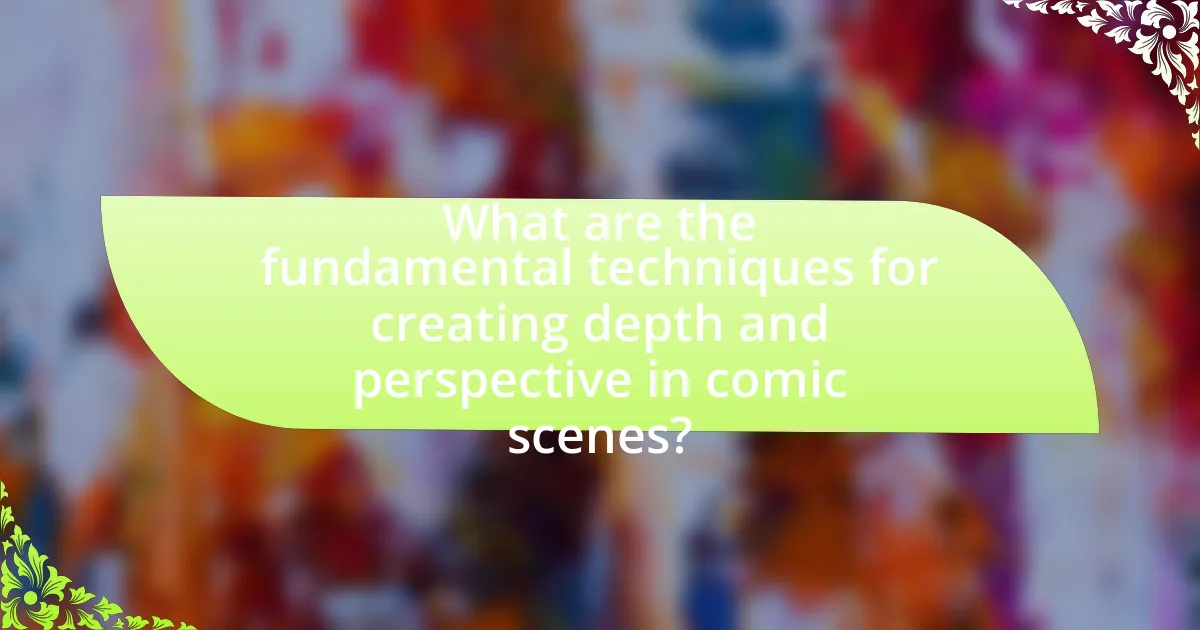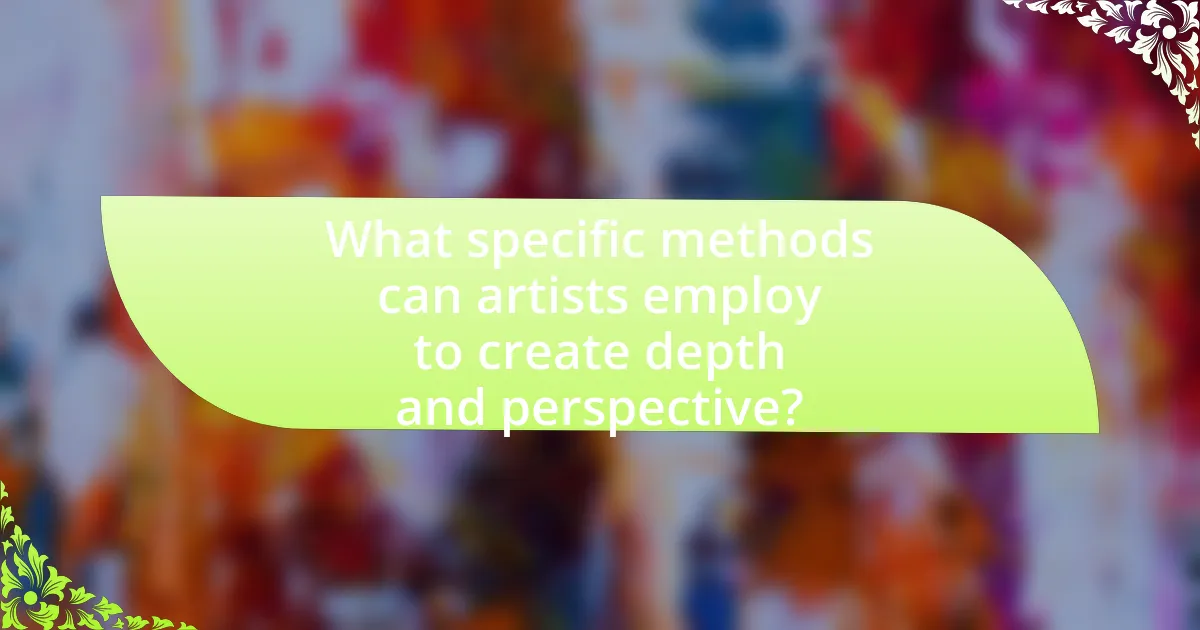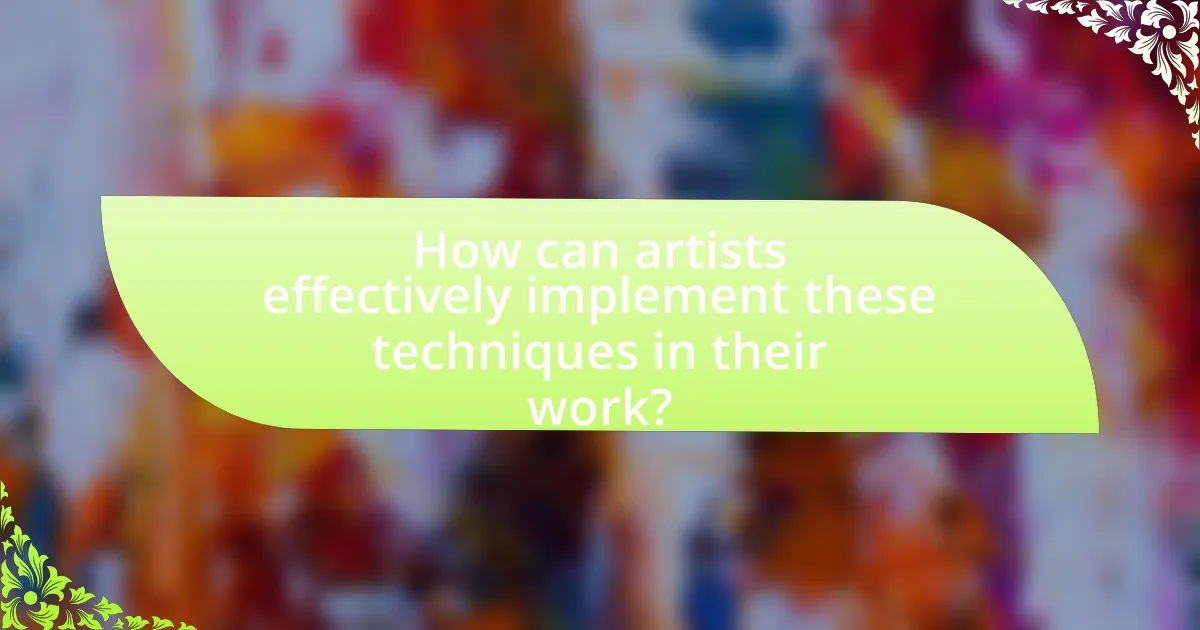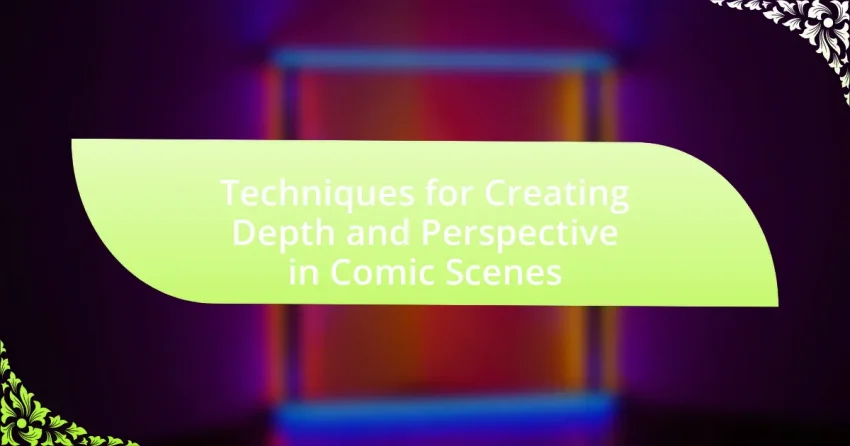The article focuses on techniques for creating depth and perspective in comic scenes, highlighting fundamental methods such as linear perspective, overlapping elements, varying sizes, atmospheric perspective, and foreground-background contrast. It explains how perspective influences viewer perception, emotional context, and storytelling, detailing different types of perspective, including one-point, two-point, and three-point perspectives. The article also addresses practical methods for establishing vanishing points, enhancing emotional impact through depth, and utilizing line weight and shading to convey three-dimensionality. Additionally, it discusses compositional techniques, common challenges artists face, and practical tips for improving depth and perspective skills in comic art.

What are the fundamental techniques for creating depth and perspective in comic scenes?
The fundamental techniques for creating depth and perspective in comic scenes include the use of linear perspective, overlapping elements, varying sizes, atmospheric perspective, and foreground-background contrast. Linear perspective involves drawing lines that converge at a vanishing point, guiding the viewer’s eye and creating a sense of three-dimensional space. Overlapping elements enhance depth by placing objects in front of one another, indicating spatial relationships. Varying sizes of objects, where closer items appear larger and distant ones smaller, reinforces the illusion of depth. Atmospheric perspective uses color and clarity to depict distance, with distant objects appearing lighter and less detailed. Finally, contrasting foreground and background elements helps to establish layers within the scene, enhancing the overall depth perception. These techniques are widely recognized in comic art and are essential for effective visual storytelling.
How does perspective influence the viewer’s perception in comics?
Perspective significantly influences the viewer’s perception in comics by shaping how depth, spatial relationships, and emotional context are conveyed. When artists utilize techniques such as one-point or two-point perspective, they create a sense of three-dimensionality that guides the viewer’s eye and enhances immersion in the narrative. For instance, a dramatic low-angle perspective can make a character appear more powerful, while a high-angle view can evoke vulnerability. This manipulation of perspective not only affects the visual hierarchy but also impacts the emotional response of the audience, as studies in visual perception indicate that perspective can alter the interpretation of a scene’s dynamics and character interactions.
What are the different types of perspective used in comic art?
The different types of perspective used in comic art include one-point perspective, two-point perspective, three-point perspective, and atmospheric perspective. One-point perspective focuses on a single vanishing point on the horizon line, creating depth by converging lines towards that point, commonly used in scenes like roads or hallways. Two-point perspective employs two vanishing points on the horizon line, ideal for depicting objects at an angle, such as buildings viewed from a corner. Three-point perspective adds a third vanishing point, typically above or below the horizon, which is effective for portraying extreme angles or tall structures, enhancing the sense of height or depth. Atmospheric perspective involves using color and clarity to suggest depth, where distant objects appear lighter and less detailed, creating a sense of distance. These techniques are foundational in comic art for conveying spatial relationships and enhancing storytelling through visual depth.
How does one establish a vanishing point in comic scenes?
To establish a vanishing point in comic scenes, an artist should first determine the horizon line, which represents the viewer’s eye level. The vanishing point is then placed on this line, where parallel lines converge, creating the illusion of depth. This technique is grounded in linear perspective, a method used since the Renaissance, where objects appear smaller as they recede into the distance. By accurately positioning the vanishing point, artists can guide the viewer’s eye and enhance the three-dimensionality of the scene, making it more engaging and realistic.
What role does depth play in storytelling within comics?
Depth in storytelling within comics enhances emotional engagement and narrative complexity. By utilizing techniques such as varying panel sizes, perspective shifts, and layering of visual elements, creators can convey a sense of space and time that enriches the reader’s experience. For instance, a close-up panel can evoke intimacy, while a wide shot can establish context and scale, allowing readers to grasp the significance of a scene. This manipulation of depth not only aids in visual storytelling but also influences pacing and tension, making the narrative more compelling.
How can depth enhance emotional impact in comic scenes?
Depth enhances emotional impact in comic scenes by creating a layered narrative that allows for complex character interactions and heightened visual storytelling. When depth is utilized, it can convey a range of emotions through varying perspectives, such as foreground and background elements that emphasize a character’s feelings or reactions. For instance, a character depicted in the foreground with exaggerated expressions can evoke empathy, while a distant background can symbolize isolation or conflict. This technique is supported by studies in visual storytelling, which indicate that depth perception significantly influences audience engagement and emotional response, making scenes more relatable and impactful.
What techniques can be used to create a sense of depth in character interactions?
To create a sense of depth in character interactions, techniques such as layered dialogue, contrasting character motivations, and non-linear storytelling can be employed. Layered dialogue involves characters expressing multiple emotions or subtext simultaneously, which adds complexity to their interactions. Contrasting character motivations creates tension and depth, as characters may have conflicting goals that influence their relationships. Non-linear storytelling allows for flashbacks or future glimpses, enriching the context of interactions and revealing character histories. These techniques enhance the emotional resonance and realism of character dynamics, making interactions feel more profound and engaging.

What specific methods can artists employ to create depth and perspective?
Artists can employ methods such as linear perspective, atmospheric perspective, and overlapping elements to create depth and perspective in their work. Linear perspective involves using a vanishing point on the horizon line to guide the viewer’s eye and create the illusion of space, as demonstrated in Renaissance art. Atmospheric perspective utilizes color and clarity to suggest distance, where objects appear lighter and less detailed as they recede into the background, a technique evident in landscape paintings. Overlapping elements involve placing objects in front of one another to establish a sense of depth, a method frequently used in comic scenes to enhance visual storytelling. These techniques are foundational in art and have been validated through centuries of artistic practice.
How can line weight and shading contribute to depth in comics?
Line weight and shading significantly enhance depth in comics by creating visual hierarchy and dimensionality. Variations in line weight can indicate distance, with thicker lines often representing objects in the foreground and thinner lines suggesting background elements. This technique helps guide the reader’s eye and establishes a sense of spatial relationships within the scene. Additionally, shading adds volume and texture, allowing characters and objects to appear three-dimensional. For instance, the use of cross-hatching or gradients can simulate light and shadow, further emphasizing depth. Studies in visual perception confirm that these techniques effectively influence how viewers interpret spatial arrangements, making line weight and shading essential tools for artists in conveying depth in comic storytelling.
What are the best practices for using line weight to indicate distance?
The best practices for using line weight to indicate distance involve varying the thickness of lines to create a sense of depth. Thicker lines typically represent objects that are closer to the viewer, while thinner lines suggest objects that are further away. This technique is supported by principles of visual perception, where the human eye interprets thicker lines as being more prominent and nearer in space. Additionally, using consistent line weight variations throughout a scene enhances the overall perspective, making it easier for the audience to understand spatial relationships.
How does shading affect the perception of three-dimensionality?
Shading significantly enhances the perception of three-dimensionality by creating contrasts that simulate light and shadow on surfaces. This technique allows viewers to interpret depth and form, as darker areas suggest recesses while lighter areas indicate protrusions. Research in visual perception indicates that shading cues, such as those described by the “light source” theory, help the brain to construct a mental model of three-dimensional objects based on their two-dimensional representations. For instance, studies have shown that images with effective shading are perceived as more three-dimensional compared to flat images, demonstrating the critical role shading plays in visual depth perception.
What compositional techniques can enhance perspective in comic panels?
Compositional techniques that can enhance perspective in comic panels include the use of vanishing points, foreshortening, and varying panel sizes. Vanishing points create a sense of depth by guiding the viewer’s eye toward a specific point in the composition, effectively simulating three-dimensional space. Foreshortening involves depicting objects or figures at an angle that makes them appear shorter than they are, which adds realism and depth to the scene. Additionally, varying panel sizes can create a dynamic flow and emphasize important elements, further enhancing the perception of depth. These techniques are widely recognized in comic art, as they help convey spatial relationships and engage the reader more effectively.
How does the arrangement of elements within a panel affect depth perception?
The arrangement of elements within a panel significantly influences depth perception by creating visual cues that guide the viewer’s understanding of spatial relationships. For instance, overlapping objects can suggest which elements are closer or farther away, while varying sizes can indicate distance, as larger objects appear nearer. Additionally, the use of linear perspective, where parallel lines converge at a vanishing point, enhances the illusion of depth. Research in visual perception indicates that these techniques effectively manipulate how viewers interpret spatial information, reinforcing the idea that thoughtful arrangement can lead to a more immersive experience in comic scenes.
What is the significance of foreground, midground, and background in comic scenes?
Foreground, midground, and background are significant in comic scenes as they establish depth, guide viewer focus, and enhance storytelling. The foreground typically contains the main characters or action, drawing immediate attention and creating a sense of intimacy. The midground serves as a transitional space that connects the foreground to the background, often providing context or additional elements that support the narrative. The background sets the scene, offering environmental details that enrich the story and contribute to the overall atmosphere. This layered composition allows artists to manipulate visual hierarchy, directing the reader’s gaze and emotional response effectively.

How can artists effectively implement these techniques in their work?
Artists can effectively implement techniques for creating depth and perspective in comic scenes by utilizing methods such as linear perspective, atmospheric perspective, and layering. Linear perspective involves drawing objects smaller as they recede into the background, which can be achieved by establishing a vanishing point on the horizon line. Atmospheric perspective can be implemented by using lighter colors and less detail for distant objects, creating a sense of depth. Layering involves placing foreground elements in front of background elements to enhance spatial relationships. These techniques are supported by principles of visual perception, which indicate that our brains interpret depth cues based on size, color, and overlap.
What are some common challenges artists face when creating depth and perspective?
Artists commonly face challenges such as accurately representing scale, managing overlapping elements, and understanding vanishing points when creating depth and perspective. Accurately representing scale is crucial because misjudging the size of objects can distort the viewer’s perception of space. Managing overlapping elements is essential, as failing to layer objects correctly can lead to confusion about their spatial relationships. Understanding vanishing points is vital, as incorrect placement can result in unrealistic perspectives, making the scene appear flat. These challenges are often compounded by the need for consistent lighting and shadowing, which further complicates the depiction of three-dimensional space on a two-dimensional surface.
How can artists overcome difficulties in maintaining consistent perspective?
Artists can overcome difficulties in maintaining consistent perspective by utilizing grid systems and reference points. Implementing a grid allows artists to establish a structured framework that guides the placement of elements in relation to one another, ensuring that all objects adhere to the same vanishing points. Additionally, using reference points, such as horizon lines and focal points, helps artists maintain spatial relationships and proportions throughout their work. Studies in visual perception indicate that consistent use of these techniques can significantly enhance the accuracy of perspective in artwork, as they provide a clear method for aligning objects within a three-dimensional space.
What tools and resources can assist in mastering depth and perspective?
To master depth and perspective in comic scenes, artists can utilize tools such as perspective grids, 3D modeling software, and drawing apps with perspective features. Perspective grids provide a structured framework for accurately depicting spatial relationships, while 3D modeling software like Blender allows artists to visualize scenes from various angles, enhancing their understanding of depth. Additionally, drawing applications like Clip Studio Paint offer built-in perspective rulers that simplify the process of creating accurate perspectives. These resources are widely recognized in the art community for their effectiveness in improving spatial representation skills.
What practical tips can help artists improve their depth and perspective skills?
To improve depth and perspective skills, artists should practice using linear perspective techniques, such as establishing a horizon line and vanishing points to create realistic spatial relationships. This method allows artists to accurately depict how objects appear smaller as they recede into the background, enhancing the three-dimensionality of their work. Additionally, artists can study and replicate the work of masters who excel in perspective, such as Leonardo da Vinci, to understand how they achieved depth in their compositions. Engaging in regular observational drawing from life, focusing on varying distances and angles, further reinforces these skills by providing practical experience in translating three-dimensional space onto a two-dimensional surface.
How can practicing with real-life references enhance perspective drawing?
Practicing with real-life references enhances perspective drawing by providing accurate spatial relationships and proportions. When artists observe real-world objects and environments, they can better understand how light, shadow, and angles interact, which is crucial for creating depth. Studies in art education indicate that using real-life references improves observational skills, leading to more realistic and dynamic compositions. For instance, a study published in the Journal of Visual Arts Practice found that students who practiced with real-life references demonstrated a 30% improvement in their ability to depict perspective accurately compared to those who relied solely on imagination. This evidence supports the effectiveness of real-life references in mastering perspective drawing.
What exercises can artists do to develop a better understanding of depth in comics?
Artists can develop a better understanding of depth in comics by practicing perspective drawing exercises. These exercises include creating one-point, two-point, and three-point perspective grids, which help artists visualize how objects recede into space. Additionally, artists can practice drawing overlapping shapes and using atmospheric perspective, where colors and details fade with distance, to enhance the illusion of depth. Studies in art education emphasize that consistent practice of these techniques leads to improved spatial awareness and depth perception in comic art.
